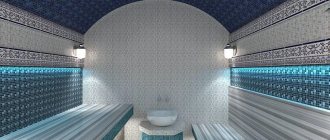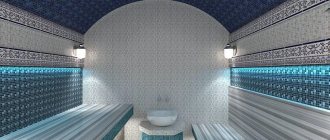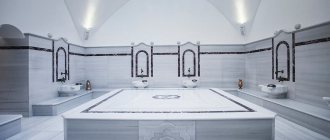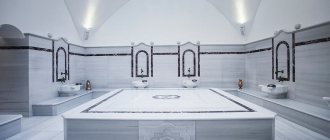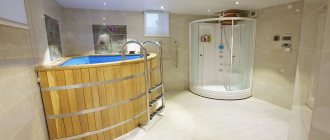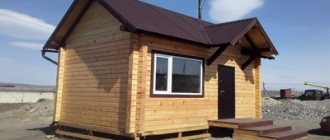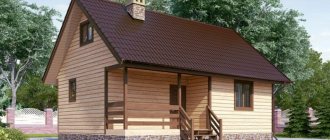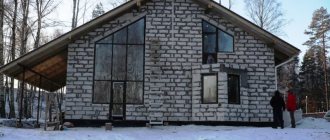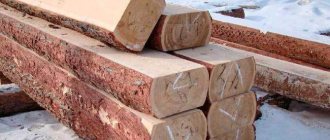Hammam and its features
The hammam is of ancient Roman origin and is derived from the thermal baths. The underground floor, which was built on stilts, was heated with a stove, and steam was supplied to the room through special holes in the wall from the next room where water was boiling. Hamam became widespread thanks to the Prophet Mohammed, who obliged all Muslims to visit it regularly, since the body of a true Muslim must be kept clean. In Russia, the first hammam appeared on the territory of Tsarskoye Selo and was built according to the design of the architect Ippolit Monighetti.
In Europe, Turkish baths became popular in the 19th century. Here they were called a panacea for many ailments and were used to treat cholera and bronchial asthma. The hammam was always built large and spacious, and marble, natural stone and mosaics were used for its luxurious decoration. A special feature of this structure was the dome-shaped vault. This architectural technique allowed droplets of moisture to accumulate only in the corner and not drip from above onto visitors.
Using lighting devices to illuminate the hammam Source 3d-sauna.ru
The hammam, familiar to Europe, in the Turkish bath is just one of the steam rooms, which is called the stream room. It is on this principle that steam rooms are built in country houses or even apartments.
The interior of the Turkish steam room is created on the principle of maximum comfort for the visitor. It is very important that the atmosphere here is conducive to rest and relaxation. The design is accordingly chosen to be oriental. The integral attributes of the hammam are mosaics, natural stone (most often light-colored marble) and ceramic tiles. Arches and domes predominate among the structural elements.
The basic principle of a Turkish bath is that the heating of each element in the room should be uniform. For this use:
- electric heating;
- special pipeline for water heating.
Installing a steam generator allows you to create soft steam. Previously, this task was accomplished by a large boiler, which was completely filled with water and heated. In classic hammams today, the required humidity is achieved by the evaporation of water droplets from surfaces heated to a certain temperature.
The loungers in the eastern bathhouse are made of marble. But, if you want to reduce the cost of construction, it can be replaced with mosaics. Moisture and thermal insulation panels made of polyurethane foam are laid under the ceramic tiles. The seats are heated thanks to water heating pipes installed in them. The loungers are made of brick, which is lined with marble tiles on top.
The walls and floors in the room are always warm. This can be achieved using pipes with heated water or electric heating. The optimal room height is considered to be 2.6 meters. Thanks to the combination of natural and forced ventilation, it is possible to achieve high-quality air exchange.
If you are going to build a hammam in a house or apartment, an air duct is connected to the hood, which ensures the removal of air from the building. Thanks to this, air, steam and odors from the hammam will not enter the living space.
Pros and cons of hamam
The main advantage that a Turkish bath has is its gentle heat, which can slowly open the pores on the skin, saturating it with moisture. Being here allows you to improve blood circulation and cleanse the body of accumulated toxins and waste. It is recommended to visit it for:
- treatment of insomnia;
- restoration of strength and energy after a long illness or intense physical activity;
- fight against colds;
- improving the functioning of the circulatory, respiratory, digestive systems;
- combating excess weight and improving metabolic processes in the body;
- reducing pain.
Although the humidity in the hammam is usually at 100%, the heat here is easily perceived by the body.
Hammam decoration in brown tones Source sami-stroim.ru
The disadvantages of hammams are:
- high energy intensity (high-quality heating of the room will require at least 3 hours);
- huge load on floors and foundations due to the use of natural stone and massive structures;
- the complexity of arranging a steam room;
- the high cost of equipment and materials used to decorate the Turkish bath.
When are they contraindicated?
Women on their period, pregnant women in the first and last trimesters, people with serious heart and vascular diseases should refrain from visiting any bathhouse. But the sauna has a more intense effect on the body, and therefore has more contraindications. It should be abandoned in the following cases:
- Exacerbation of diseases and heat intolerance.
- ARVI with high fever.
- Weeping and purulent skin diseases.
- Malignant tumors.
- Convulsive seizures and various forms of epilepsy.
- After head injuries and surgeries.
- Rheumatism with dysproteinemia, active corticosteroid therapy.
- Tumors and sclerosis of the kidneys with dysfunction, chronic glomerulonephritis.
- Inflammation of the peritoneum, diarrhea, subacute diseases, colitis, chronic hepatitis.
The effect of hammam is more gentle, so there are fewer contraindications. These are diseases:
- Respiratory system (severe).
- Thyroid and varicose veins.
- Oncological.
- Inflammations on the skin.
Hammam design
Before you start building a hammam, it is important to plan everything correctly. The process of constructing a Turkish bath is lengthy and requires significant financial investments. Each step must be properly thought out and calculated:
- First, measurements of the room are taken, taking into account its height and width.
- A design project is being drawn up. This includes determining what the finishing will be like and where the beds and sun beds will be located.
- It is planned to place lamps, ventilation holes, a steam generator, sewerage, etc.
- The heating system for sunbeds, walls and other surfaces is calculated.
Shower in a Turkish bath Source thermall.com.ua
If you plan to make a hammam in a residential building, it is important to consider the option of covering the walls and constructing thermal insulation. To prevent moisture from having a detrimental effect on the walls, they are pre-treated with a special compound. Waterproofing in the hammam is done in such a way as not to cause damage to the building. Proper thermal insulation will keep the room warm without heating up neighboring rooms.
Turkish bath construction projects are carried out by specialists. But if you have certain knowledge and skills, you can do this yourself. It is important to take correct measurements and select finishing materials.
Drawing up a work plan begins with designing the ceiling. The future layout will depend on its size. Here it is important to correctly calculate the angle of inclination so that moisture can easily flow along the edges without forming drops directly on the surface of the ceiling. The extreme point of the ceiling structure must be at a height of at least 2.7 meters. At a level of 2.2 meters, the dome turns into a container where condensate will flow. Moreover, the angle of inclination itself should be minimal.
If the structure is not designed correctly, a significant area of the room will be lost. The room can be rounded, flat, or have the appearance of a honeycomb. A step-down transformer is installed in the steam room for lighting fixtures.
Using mosaics to decorate surfaces in a Turkish bath Source bani.org.ua
In order for the steam room to fully function, it is necessary to make a technical room where the support systems and the steam generator will be located. Usually this is a small room or even a compartment combined with the main steam room. The ideal technical room area is 1.5 m².
Another point that is important to pay attention to is the ventilation outlet, where steam can cool and collect on the surface of the air duct. If a mistake is made when creating the channel, then all the moisture will begin to accumulate in the recesses, and can cause the formation of mold or the development of fungus.
Spacious hammam with columns Source helo.com.ua
Ventilation diagram
The hammam must always maintain a certain air temperature, which must circulate in the room. The ventilation system can be flow-through or forced. For this purpose, ventilation pipes can be installed. In this case, it is necessary to take into account:
- room layout;
- design features of the hammam.
The pipe through which air exchange will take place must be sealed. The ideal option would be a stainless steel pipe. In most cases, during the construction of a Turkish steam room, mixed ventilation is created. To do this, make several holes in the walls, which will be located opposite each other.
Construction of a dome in a hammam from plasterboard Source hamamtorg.ru
When designing multi-level ventilation, recesses are made at different levels. This design option will allow you to maintain a certain temperature level inside the room throughout the year.
Hammam dimensions
When determining the area of the room, you must remember that the larger it is, the more powerful the generator you need to buy. If the bathhouse will be used by a family of 4-5 people, a room of 2.5 * 2.5 m will be optimal. A larger steam room is made if it is planned to install a massage table here. For one steam generator to be enough, the room size must be at least 3.5 m².
The optimal height of a massage table is 70 cm. If it is higher, it will be uncomfortable for a person of average height to do a massage.
Turkish steam room with massage table Source turistics.com
It is worth considering that the materials used for waterproofing and finishing the room take at least 3-4 cm. If you plan to reinforce the walls, then another 2.3 cm will be lost.
The following can be used in the hamam:
- seating areas with a flat surface;
- curved shelves;
- structures for sitting or lying.
When determining the location where there will be holes for the steam to escape, make sure that it cannot burn your feet. The height at which the hole is located is 20-30 cm from the floor.
Features of the construction and decoration of the hamam premises Source teplodar.in.ua
INTERIOR ELEMENTS
Sun lounger. Needed for complete relaxation. There is no way to install it in a personal hammam, but in a compact one it is quite possible to combine it with a regular or anatomical bench.
Anatomical shop. Much more convenient than usual. Has an anatomically shaped bench. If you want to sit comfortably, choose this option. If you want to save money, don’t check the box.
A massage table. Doesn’t fit into a personal hammam at all (skip the option). And it takes up quite a lot of space in a compact one. But, if you really love massage and are willing to sacrifice convenience and one seat, choose this option.
Kurna. In classical oriental traditions, it is a stone bowl. Usually 2 kurnas are installed (with warm and cool water). But in small hammams, where every centimeter is worth its weight in gold, it is quite possible to get by with one sink, with two taps installed above it and a drain into a pipe. Or even replace the kurna with a shower hose for comfortable water procedures.
Requirements for the hamam premises
When planning to make a hammam at home, it is important to remember the following rules:
- All surfaces in the steam room must be strong and finished with natural stone. Ceramic tiles can become a cheaper alternative to natural materials.
- A hammam will require at least 4 rooms. In one of them there will be a steam room itself, in another there will be a technical room, in the third there will be a shower and in the fourth there will be a place for relaxation and preparation for water or health procedures.
- The ceiling height cannot be less than 2.5 meters.
- The ventilation system and sewerage are important components of any hammam.
If the construction of a hammam is planned on the territory of a private household, then the technical room must be moved outside the building no more than 15 meters. The rest room should not be adjacent to the steam room. To build a hammam, it is better to use bricks or blocks. If the room is made of wood, then it must be pre-treated with a special protective compound.
The hammam room is round in shape Source asc.cv.ua
The history of hammams
The Roman baths impressed the Arabs so much that they began to build the same ones, but taking into account religious views. And so the first hammam appeared on the shores of the Red Sea. After which steam baths spread throughout all Islamic territories. The Arabs excluded from their baths a large pre-bath area, where the Romans had a library, stadium, and club.
Roman baths
Five rooms with different temperatures and a large round stone in the center of the hammam are also Arab innovations. Various temples, the decoration of which was luxurious, were used as hammams. This can be observed to this day.
A little later, the idea of hammams was adopted by the Turks, and the baths became “Turkish”. With the development of Islam, hammams spread towards Asia. At the same time, the rituals of the Turkish bath were enriched, new features appeared in the form of multi-stage ablution, massage, and cosmetic procedures. As a result, hammam baths became a place not only for washing, but also for rest, relaxation, and wellness treatments.
How to choose material?
The material that will be used for the construction or decoration of the hammam must be:
- durable;
- withstands high temperatures;
- moisture resistant.
The ideal material is natural marble. This material is strong, durable, pleasant to the touch and has a status appearance. The only drawback of the stone is its high price. To reduce possible temperature changes, marble can be replaced with telcochloridote. The cost of this material is almost the same as that of marble, but its heat capacity is higher.
Features of the construction of a Turkish bath Source banyabest.ru
Instead of marble, you can use ceramic tiles or mosaics. Using smalt, you can create beautiful designs in oriental style. This material can be plates or small tiles. Their surface can be bright or colorless, smooth or rough. The advantage of smalt is that it can be laid even on a curved surface, while for tiles it must be perfectly flat. Other advantages of smalt include:
- frost and heat resistance;
- variety of shades;
- zero water absorption.
The only drawback of this material is the installation time. Therefore, manufacturers began to make ready-made panels that made work easier. The most budget-friendly and easiest-to-install material is ceramic tiles.
Decorating a sun lounger in a Turkish bath Source ideaspa.ru
The origins of the ancient tradition
The first baths in Turkey began to be built at the beginning of the 17th century. If we turn to the chronicles, the Turks adopted their first experience in maintaining personal hygiene from the Arabs, and they received their secrets from the ancient Romans. Many historians provide quite convincing evidence in favor of the fact that the hammam became a unique national variation of the Roman baths.
Interest in hammam baths began to increase at the time when Islam came to eastern countries. The baths became so popular that sometimes ancient temples of other religions were even converted into them. It was necessary to carry out rather labor-intensive work to re-equip the premises in order to comply with the requirements of multi-stage procedures. They were changed to such an extent that the baths in every detail exactly corresponded to the Turkish style.
Continuing to get acquainted with the history of the hammam, you can find out that the first examples of these baths did not have significant advantages. But the years passed, and traditions of visiting Turkish baths gradually formed. A clear confirmation of this was the steam room, which turned into a place for massage. This was an innovation for the hammam - there was no such thing in the Roman baths. The necessary changes were made to the dry steam room, as a result of which it turned into a “sweating room”.
Today, in our country, you can find Turkish hammams, but, as happened with other types of baths, these were just clones, unable to provide the required effect. Therefore, if you want to feel the bliss of visiting a real hammam, then you should go to Istanbul or Bukhara, where classic hammams are still preserved. In these cities, long-term buildings still continue to function, which the owners monitor and do not even think about making changes to them.
The process of creating a hamam
If the Turkish bath project is ready, you can begin the process of its construction. To do this you will need the following tools:
- level;
- plumb line;
- perforator;
- hammer with rubber surface;
- putty knife.
Construction work begins with choosing a suitable location. On average, construction will take several months. It is not necessary to build a special structure under the hammam, which will be located separately from the residential part of the house. Any building is suitable for this; it is important that all requirements are met.
For a Turkish bath you need to make at least 2 rooms. The steam room itself will be located in one, and the technical compartment in the other. The necessary communications (sewage, water supply, electricity, ventilation, heating) are carried out here. The area of the room will depend on the wishes and needs of the owner. The technical compartment is necessary to accommodate the cleaning filter, steam generator and other devices that ensure high-quality operation of the steam room.
Foundation and walls
Such a structure will require the creation of a strip foundation. Do it as follows:
- The surface of the site is leveled and a pit is made on it.
- Based on the planned dimensions of the structure, pegs are driven in, along which wooden formwork is created.
- The fittings are being installed.
- Concrete is poured.
Decorating walls in a Turkish bath with marble Source teplodar.in.ua
It is important to leave the foundation for at least 30 days for proper drying. After this, the construction of walls begins:
- Waterproofing material is laid on the base.
- Several levels of the selected building material are laid out on top of the edge, starting from the top corner.
- The seam between blocks is up to 5 mm.
- The reinforcement mesh strengthens the base.
Decorating the walls in the hammam with blue and white mosaics Source sauna-psp.kiev.ua
How to use the hammam?
Unlike the Russian bathhouse we are used to, the hammam is less hot. Thanks to this, water treatments here are more comfortable and do not tire you even after a long stay in the steam room. Since the humidity here is very high, it is easy to recreate tropical conditions in the hammam, which will make it possible to stay here with health benefits.
The air temperature in the locker room should be about 30 degrees. In the steam room this figure is much higher and can reach 70 degrees. To make your stay here comfortable and tireless, it is recommended to set the temperature at 37-40 degrees.
Illumination of a lounger in a hammam Source goodpools.ru
When visiting the hammam, you must adhere to the following recommendations:
- It is important to warm up your body first. In this case, you just need to lie down and wait until droplets of sweat appear on the skin.
- The appearance of sweat indicates that the body is ready for further procedures. Only then can you begin a massage session, during which a solution of soap and a mixture of oils is applied to the skin. Olive and peach oils are usually used. To better cleanse dead skin cells, massage is best done with special gloves made of natural wool.
- Using warm water in the kurna, wash off the soap and oil mixture from the skin.
- To close the pores, take a cool shower.
If you ignore these recommendations, you may harm your health.
Using red mosaic to decorate a hamam Source yuventa.com.ua
Optimal temperature indicators
The human body temperature in any environment is no more than 40 0. This is achieved by the fact that when the ambient temperature rises, a person sweats and releases excess heat with moisture into the surrounding air. This is the basis for the effect of any bath; they differ in the ratio of temperature and air humidity.
The best state of health at a certain combination of humidity and temperature is graphically expressed by homeothermal curves: below the first curve is the optimal combination of temperature up to 90 0 and humidity up to 80%. It is the combination of temperature of about 40% and almost one hundred percent humidity that gives hammams.
Homeothermal curves - theoretical dependences of relative humidity on temperature
